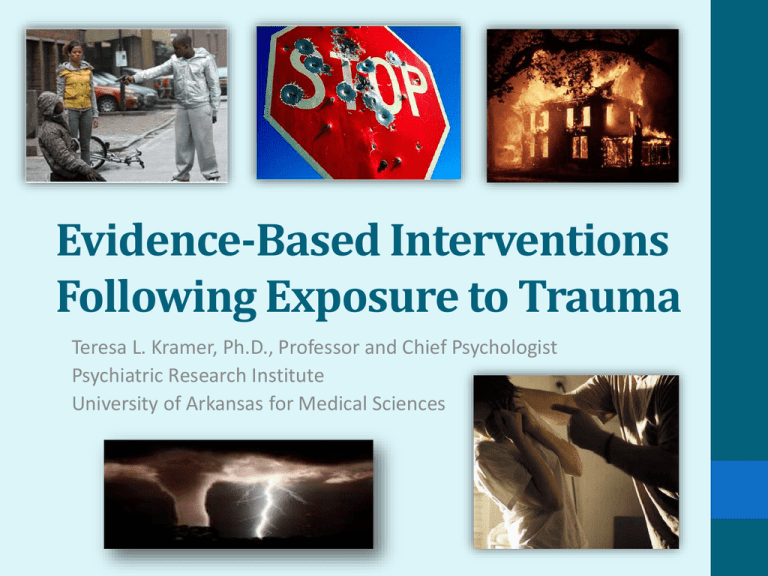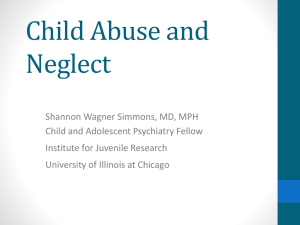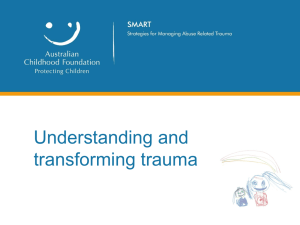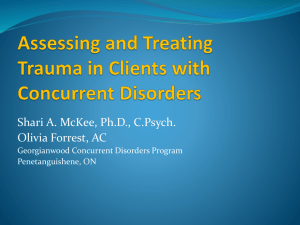the PowerPoint - Arkansas Psychiatric Society
advertisement

Evidence-Based Interventions Following Exposure to Trauma Teresa L. Kramer, Ph.D., Professor and Chief Psychologist Psychiatric Research Institute University of Arkansas for Medical Sciences Objectives • Highlight recent research documenting the longterm, multi-generational, multi-systemic impact of trauma • Compare diagnostic formulations of posttraumatic stress disorder from DSM-IV to DSM-V • Describe recent psychotherapeutic and pharmacological developments in the treatment of PTSD Objectives • Highlight recent research documenting the longterm, multi-generational, multi-systemic impact of trauma PTSD – From Trauma to Maladaptive Coping Brains Have the Ability to Adapt to Environment • Allostasis: Physiological adjustment to environmental pressures Ganzel et al 2010 • Allows organism to adapt to circumstances • Increased arousal is adaptive when running from a bear or when experiencing a trauma • Allostatic load: cumulative consequences of allostasis: • Physiological state is (semi-) permanently changed • Adaptive if I live in a place with lots of bears or if I’m chronically abused as a child Gets stronger in chronically stressful environments Gets weaker in chronically stressful environments Amygdala – allows us to detect objects/situations that are biologically relevant Medial Prefrontal Cortex – allows us to control our emotions when needed A Metaphor for Structural Brain Consequences of Chronic Stress Amygdala + OFC Density = Speed of River Current Hippocampus+ PFC Density = Strength of Dam With chronic stress, river current gets faster and faster, while strength of dam gets weaker and weaker. Adverse Childhood Experiences (ACE) • One of the largest investigations ever conducted to assess associations between childhood maltreatment and later-life health and well-being. • Collaboration between the Centers for Disease Control and Prevention and Kaiser Permanente's Health Appraisal Clinic in San Diego. • 17,000 Health Maintenance Organization (HMO) members • Comprehensive physical examination • Detailed information about childhood experience of abuse, neglect, and family dysfunction • More than 50 scientific articles published Risk Factors Related to ACE As the number of ACE increase, the risk for the following health problems increases in a strong and graded fashion: • • • • • • • • • • • • • • • • • Alcoholism and alcohol abuse Chronic obstructive pulmonary disease (COPD) Depression Fetal death Health-related quality of life Illicit drug use Ischemic heart disease (IHD) Liver disease Risk for intimate partner violence Multiple sexual partners Sexually transmitted diseases (STDs) Smoking Suicide attempts Unintended pregnancies Early initiation of smoking Early initiation of sexual activity Adolescent pregnancy Fetal Origins of Adult Disease (genetics) Impact of Glucocorticoids (environment) Impact of Exposures Maternal Abuse History and Infant Baseline Salivary Cortisol Baby Baseline Cortisol 0.6 0.5 0.4 0.3 No Abuse History Abuse History 0.2 0.1 N = 78 0 N = 26 Maternal Abuse History, PTSD and Infant Cortisol Reactivity Log AUC Relative to Baseline 2.45 2.4 2.35 No Abuse History 2.3 Abuse History 2.25 2.2 2.15 All No PTSD Subjects (Brand et al PNEC 2008) PTSD 45.5% p=.016 Percent of Subjects Requiring Emergency C-Section 50% 45% Impact of Severe Early Abuse on Outcome 40% 35% 30% 14.3% 25% 20% 15% 10% 5% 0% Not Exposed to 2 or More Types of Severe Abuse Exposed to 2 or More Types of Severe Abuse Maternal History of Severe Childhood Abuse Predicts Increased Risk of Neonatal Respiratory Distress Syndrome p=.017 40.0% Percent of Subjects whose Neonates had Respiratory Distress Syndrome 50% 45% 40% 35% 30% 25% • Control for diagnoses, symptoms in pregnancy, other exposures, AD, etc. • Women with history of severe abuse (sexual, physical, emotional), had higher rates: • Emergency C/S • Hypertension in pregnancy • Low birth weight (<2500 gm) • Neonatal respiratory distress • Maternal Urine Cotinine associated with LBW, Neonatal Symptoms 20% 15% 3.6% (Weiss et al Thesis MCR Program) 10% 5% 0% Not Exposed to 2 or More Types of Severe Abuse Exposed to 2 or More Types of Severe Abuse Maternal Report – CBCL and Early Abuse • Affective Problems • (t=3.64; p=0.0004) Offspring Affective Problem Score 3.0 2.5 2.0 1.5 1.0 0.5 0.0 No Yes Maternal Sexual Abuse • Anxiety • (t=4.25; p<0.0001) Offspring Anxiety Score 3.5 3.0 2.5 2.0 1.5 1.0 0.5 0.0 No • Oppositional Defiant Smith A. et al SOBP 2009 Offspring Oppositional Definant Score • (t=1.98; p=0.049) Yes Maternal Sexual Abuse 3.5 3 2.5 2 1.5 1 0.5 0 No Yes Maternal Sexual Abuse Summary • Maternal – Early Adverse Life Events • Higher rates of the following: • • • • C-Section Hypertension in pregnancy Low birth weight Neonatal respiratory distress • Decreased cord (fetal) HPA response to delivery • Lower baseline infant cortisol at 6 months • Higher infant cortisol reactivity at 6 months • Later Infant/Child Follow Up • Depression and early abuse associated with adverse effects Multi-Generational Impact The cumulative burden borne by offspring whose mothers were sexually abused as children: descriptive results from a multigenerational study. Abstract This multigenerational study empirically demonstrates the extent to which offspring whose parents experienced childhood abuse are at increased risk of being abused or neglected. Females with substantiated childhood sexual abuse and non abused comparison females were assessed at six points spanning 18 years in a prospective, longitudinal study. Non abusing parents or caregivers and offspring were also assessed. Descriptive results indicate that offspring born to mothers with histories of sexual abuse were more likely to be born preterm, have a teenage mother, and be involved in protective services. Abused mothers were more likely to be high-school dropouts, be obese, and have experienced psychiatric problems, substance dependence, and domestic violence. Results provide evidence for the advantages of intervention and prevention programs for victims of childhood maltreatment and their families. Primary prevention/intervention efforts extending throughout development and focusing on the cumulative risk to offspring will likely improve victim outcomes and curtail intergenerational transmission of adversity (Noll JG, Trickett PK, Harris,WW, Putnam FW, 2009) Objectives • Compare diagnostic formulations of posttraumatic stress disorder from DSM-IV to DSM-V DSM Overview • No longer categorized as an anxiety disorder; currently identified as “Trauma- and Stressor-Related Disorder” • Category also includes Reactive Attachment Disorder and Disinhibited Social Engagement Disorder • Separate diagnosis for children six years and younger (Posttraumatic Stress Disorder for Children Six Years and Younger) • Includes “secondary victimization,” (e.g., police officers repeatedly exposed to details of child abuse) • Does not require that the initial response involved “intense fear, helplessness or horror” (second part of Criterion A that has been controversial) • Symptoms described as “beginning after the “traumatic event occurred” DSM Changes • DSM-IV-TR • Intrusive Symptoms (1 or more) • Distressing recollections • Distressing dreams • Acting/feeling as if the event were recurring • Intensive psychological distress at reminders • Physiological reactivity to reminders • DSM-V • Intrusive Symptoms (1 or more) • Distressing memories • Distressing dreams • Dissociative reactions • Intense psychological distress at reminders • Marked physiological reactions to reminders DSM Changes (continued) • DSM-IV-TR • Avoidance (3 or more) • Avoidance of thoughts/feelings related to trauma • Avoidance of activities, places related to trauma • Can’t recall memories of trauma • Diminished interest • Detachment • Restricted affect • Sense of foreshortened future • DSM-V • Avoidance (1 or more) • Avoidance of distressing memories, thoughts, feelings related to trauma • Avoidance of external reminders related to trauma DSM Changes (Continued) • DSM-IV-TR • Included under avoidance • Included under avoidance • Included under avoidance • Included under avoidance • DSM-V • Negative alterations in cognitions and moods related to trauma (2 or more) • Can’t recall memories of trauma • Negative beliefs about oneself • Persistent/distorted cognitions about trauma • Persistent negative emotional state • Diminished interest • Detachment/estrangement • Inability to experience positive emotions DSM Changes (continued) • DSM-IV-TR • Hyperarousal (2 or more) • Difficulty with sleep • Irritability or anger • Concentration problems • Hypervigilance • Exaggerated startle • DSM-V • Hyperarousal (2 or more) • Difficulty with sleep • Irritability or anger • Concentration problems • Hypervigilance • Exaggerated startle • Reckless or selfdestructive behavior Objectives • Describe recent psychotherapeutic and pharmacological developments in the treatment of PTSD Psychological Treatments • Adults • • • • • Cognitive-Exposure Therapy (3 studies) Cognitive Processing Therapy (4 studies) EMDR (3 studies) Cognitive Therapy (3 studies) CBT Mixed (6 studies) • Children & Adolescents • Prolonged Exposure Therapy (1 study; adolescents only) • Trauma-Focused Cognitive-Behavioral Therapy (TF-CBT) (5 studies; C&A) • Risk Reduction through Family Therapy (1 study; adolescents only) • EMDR (3 studies; C&A) • Cognitive Processing Therapy (1 study; adolescents only) • Parent Child Interaction Therapy (3-7 years) • Child Parent Psychotherapy (1 study; <6 years) • Cognitive-Behavioral Therapy – Various Forms (7 studies; C&A) Pharmacological Treatments • SSRI • Fluoxetine • Paroxetine • Sertraline • SNRI • Venlafaxine • Anti-Convulsant • Topiramate • Evidence insufficient for all other medications Jonas, DE, Cusack, K, Forneris, CA, Wilkins, TM, Sonis, J, Middleton JC, Feltner, C, Meredith, D, Cavanaugh, J, Brownley, KA, Olmsted, KR, Greenblatt, A, Weil, A, Gaynes, BN. (2013). Psychological and pharmacological treatments for adults with posttraumatic stress disorder (PTSD). Comparative Effective Reviews, No. 92, RTI International–University of North Carolina Evidence-based Practice Center Rockville (MD): Agency for Healthcare Research and Quality , Report No.: 13-EHC011-EF; https://www.ncbi.nlm.nih.gov/books/NBK137707/ Leenarts, L.EW, Diehle, J, Doreleijers, TAH, Jansma, EP, Lindauer, RJL. (2013). Evidence-based treatments for children with trauma-related psychopathology as a result of childhood maltreatment: a systematic review. European Child & Adolescent Psychiatry, 22: 269-283. Complex PTSD • Phased-Oriented or Sequential Treatment 1. Stabilization and skills strengthening • Patient safety • Strengthening individual’s capacities for emotional awareness/expression, interpersonal and social competencies 2. 3. Review and reappraisal of trauma memories Consolidation of gains • Application of skills • Future plans • Use of “booster” sessions PRI Research with Adolescent Girls • NIMH-funded study to identify brain correlates of psychological treatment outcome for adolescent girls with PTSD • 12 sessions of TF-CBT free of charge • Conduct a clinical interview and brain scan before and after treatment • Monetary compensation for time • Child gets ~$225; parent gets $75 • Monetary compensation for travel to each visit to UAMS (~15 vists * $15 per visit) • Inclusion criteria: • Female, aged 11-16, PTSD related to physical or sexual assault • Contact: • Sonet Smitherman: 526-8386; smsmitherman@uams.edu • Josh Cisler: 526-8343; jcisler@uams.edu Programmatic Initiatives Arkansas Building Effective Services for Trauma The mission of AR BEST is to improve outcomes for traumatized children and their families in Arkansas through excellence in clinical care, training, advocacy and research/evaluation. Programmatic Initiatives • Arkansas Network for Early Stress and Trauma (Arkansas NEST) • Collaboration between PRI, Mid-South Health Systems, and Ozark Guidance Center and funded by the Substance Abuse and Mental Health Services Administration Member of the National Child Traumatic Stress Network (NCTSN) • To increase services in Arkansas for children aged 0-5 years who have experienced trauma Acknowledgements • Zachary Stowe, M.D., Director of PRI’s Women’s Mental Health Program • Josh Cisler, Ph.D., PRI Assistant Professor









